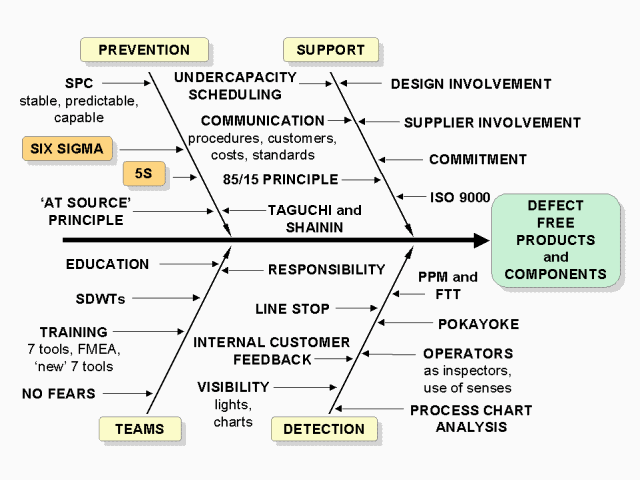
Lean and TOTAL QUALITY

Quality works in partnership with Lean. As Lean is implemented, quality improves and vice versa. Why? Because improved visibility, regularity, smaller batches, reduced space, less inventory, and so on all directly impact on quality. And improving quality makes pull systems and scheduling work better. Apart from cost and waste, improving quality is about reducing the great enemy - variation.
A fundamental idea of quality management, prevention is more cost effective than inspection, and much cheaper than failure.
Statistical Process Control is a prevention approach with the SPC goal of stable, predictable, and capable processes. SPC charts should be kept lineside. The goal should always be to continually improve the capability index (Cpk). Inspect the process, not the product. Remember SPC charts are powerful in distinguishing common causes from special causes. Tinkering with the former simply makes matters worse.
Six Sigma is dealt with in a separate section. It should not be thought of as replacing total quality, but as one powerful means to achieve improvement. Likewise, 5S.
The 'At Source Principle' is that quality problems should be dealt with right there and then. It is about operator responsibility: never knowingly pass on a defective.
Taguchi Methods, also known as design of experiments, allow one to home in on the most quality critical variables economically and rapidly. Shainin methods are a variation, to search for the 'Red X'. Shainin methods range from simple to sophisticated, and are powerful. Both Shainin and Taguchi methods deserve wider attention.
If capacity is scheduled to 100% of time, there will be no time to correct errors or make improvements. So schedule deliberately under full capacity to take the pressure off and allow initiative and decision making to happen - also to guarantee to hit the schedule.
Communication of correct procedures from designers and engineers is required. Spend as much time as is needed. 'Sit by Nelly'. Use sketches and photos to communicate standards. Some allow operators to talk directly with customers and suppliers.
Demings 85/15 principle states that 85% of quality problems are ultimately traceable to management, only 15% to operators. Poors specs, poor training, and unclear requirements are typical causes.
Design Involvement means perhaps 80% of defects eliminated before they even get to the line. Think Design for Assembly (DFA) for ease of assembly, and Toyota sending a design team to live in California, near customers, for the Lexus product concept. Supplier involvement is also good for simplification. Close the communication gap between design and manufacture.
Commitment (one of Oakland's 3 C's of Culture, Communication and Commitment) on the part of managers is required. Inspirational examples abound: Galvin at Motorola, Welsh at GE, Egan at Jaguar.
ISO 9000 is not great at quality improvement, but lays many a foundation for good practice. The revised version for 2000 shows promise.
Teams need education in the 7 basic tools of quality, perhaps in the new tools, and FMEA and others (see also Six Sigma). All this needs to take place in a 'no fears' climate - defect detection is good, no one need fear for jobs as a result of improvement. Teams also need to take responsibility for quality in their own cells and areas.
Although prevention is the goal, detection is essential. Pokayoke (error proofing) devices carry out 100% automatic checks with either stop or warning when a defect is detected.
Parts per million (ppm) has become a standard measure of quality. This is often measured at the output stage. But first time through (ftt) is a better measure for process quality. This measures the percentage of parts per million that pass through all stages without any rework or scrap. It is quite possible to have a very low ppm rate, but a ftt rate of 100% or 1 million.
Operators come with built-in vision and hearing - use it! When problems are detected they should be fed back to the source immediately; no delay.
Line Stop (the classic is at Toyota) means operators are empowered to stop the line to prevent defects from proceeding. This is an example of immediate feedback and real empowerment. Less powerful systems use lights and sound but are still good.
Process Chart analysis can give important clues to problems as well as being used for process control.